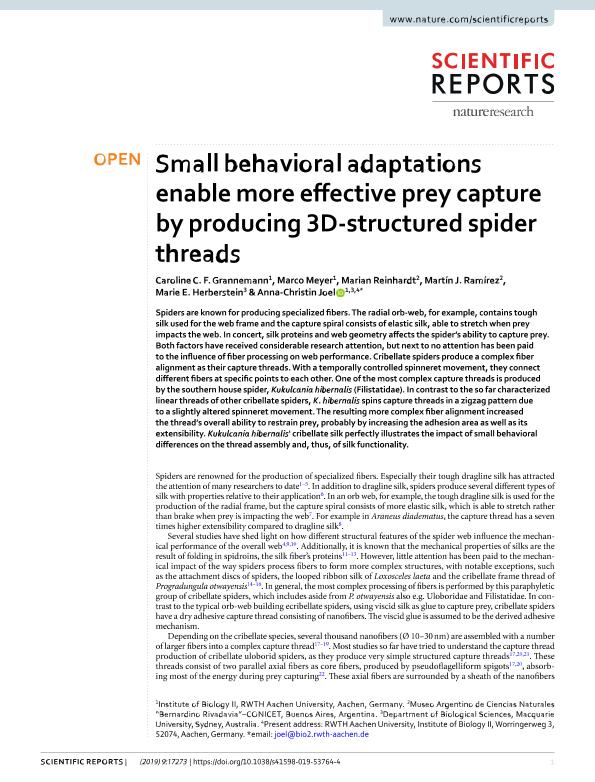Mostrar el registro sencillo del ítem
dc.contributor.author
Grannemann, Caroline C. F.
dc.contributor.author
Meyer, Marcos

dc.contributor.author
Reinhardt, Marian
dc.contributor.author
Ramirez, Martin Javier

dc.contributor.author
Herberstein, Marie E.
dc.contributor.author
Joel, Anna Christin
dc.date.available
2021-02-03T14:35:24Z
dc.date.issued
2019-12
dc.identifier.citation
Grannemann, Caroline C. F.; Meyer, Marcos; Reinhardt, Marian; Ramirez, Martin Javier; Herberstein, Marie E.; et al.; Small behavioral adaptations enable more effective prey capture by producing 3D-structured spider threads; Nature Publishing Group; Scientific Reports; 9; 1; 12-2019; 1-10
dc.identifier.issn
2045-2322
dc.identifier.uri
http://hdl.handle.net/11336/124591
dc.description.abstract
Spiders are known for producing specialized fibers. The radial orb-web, for example, contains tough silk used for the web frame and the capture spiral consists of elastic silk, able to stretch when prey impacts the web. In concert, silk proteins and web geometry affects the spider’s ability to capture prey. Both factors have received considerable research attention, but next to no attention has been paid to the influence of fiber processing on web performance. Cribellate spiders produce a complex fiber alignment as their capture threads. With a temporally controlled spinneret movement, they connect different fibers at specific points to each other. One of the most complex capture threads is produced by the southern house spider, Kukulcania hibernalis (Filistatidae). In contrast to the so far characterized linear threads of other cribellate spiders, K. hibernalis spins capture threads in a zigzag pattern due to a slightly altered spinneret movement. The resulting more complex fiber alignment increased the thread’s overall ability to restrain prey, probably by increasing the adhesion area as well as its extensibility. Kukulcania hibernalis' cribellate silk perfectly illustrates the impact of small behavioral differences on the thread assembly and, thus, of silk functionality.
dc.format
application/pdf
dc.language.iso
eng
dc.publisher
Nature Publishing Group

dc.rights
info:eu-repo/semantics/openAccess
dc.rights.uri
https://creativecommons.org/licenses/by/2.5/ar/
dc.subject
cribellate
dc.subject
nano
dc.subject
silk
dc.subject
adhesion
dc.subject.classification
Biofísica

dc.subject.classification
Ciencias Biológicas

dc.subject.classification
CIENCIAS NATURALES Y EXACTAS

dc.title
Small behavioral adaptations enable more effective prey capture by producing 3D-structured spider threads
dc.type
info:eu-repo/semantics/article
dc.type
info:ar-repo/semantics/artículo
dc.type
info:eu-repo/semantics/publishedVersion
dc.date.updated
2020-11-26T17:45:54Z
dc.journal.volume
9
dc.journal.number
1
dc.journal.pagination
1-10
dc.journal.pais
Reino Unido

dc.journal.ciudad
Londres
dc.description.fil
Fil: Grannemann, Caroline C. F.. Rwth Aachen University; Alemania
dc.description.fil
Fil: Meyer, Marcos. Rwth Aachen University; Alemania
dc.description.fil
Fil: Reinhardt, Marian. Consejo Nacional de Investigaciones Científicas y Técnicas. Oficina de Coordinación Administrativa Parque Centenario. Museo Argentino de Ciencias Naturales "Bernardino Rivadavia"; Argentina
dc.description.fil
Fil: Ramirez, Martin Javier. Consejo Nacional de Investigaciones Científicas y Técnicas. Oficina de Coordinación Administrativa Parque Centenario. Museo Argentino de Ciencias Naturales "Bernardino Rivadavia"; Argentina
dc.description.fil
Fil: Herberstein, Marie E.. Macquarie University; Australia
dc.description.fil
Fil: Joel, Anna Christin. Macquarie University; Australia. Rwth Aachen University; Alemania
dc.journal.title
Scientific Reports
dc.relation.alternativeid
info:eu-repo/semantics/altIdentifier/url/https://www.nature.com/articles/s41598-019-53764-4
dc.relation.alternativeid
info:eu-repo/semantics/altIdentifier/doi/https://doi.org/10.1038/s41598-019-53764-4
Archivos asociados
